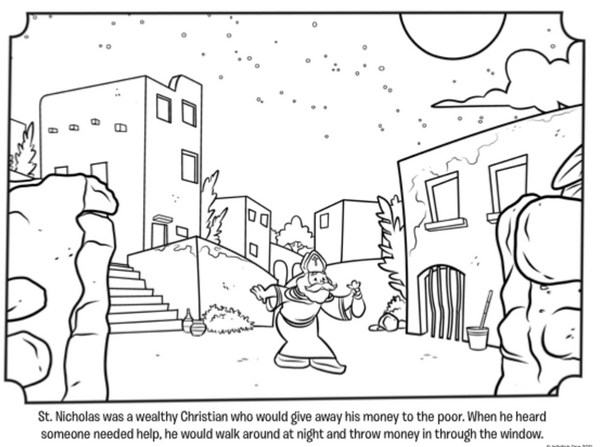Who is Santa Claus?

Who is Santa Claus? Jolly Old Saint Nicholas, Father Christmas, Kris Kringle, Santa! Who is he? Where did he come from? It turns out our beloved Christmas icon originates with from a bishop in the church in the 300s. Legend says that Saint Nicholas gave money to the poor, and later the church declared December 6th to be Saint Nicholas Day. In the early 1800s, Saint Nicholas – now known as Santa Claus, from the Dutch “Sinter Klaas” – became popular in the United States. Many of our modern traditions around Santa come from an anonymous poem published in 1823 called “A Night Before Christmas.”
The Beginnings of Saint Nicholas
Long before the legend of Santa Claus took hold in the United States, a man named Nicholas led a church in Asia Minor. Saint Nicholas was the bishop of Myra (in present day Turkey) in the 300s. Beyond this, little is known about the actual life of this popular saint. However, many legends have developed over the centuries. Facts probably stand behind a few of these legends, but regardless of their historicity, the legends have shaped the way people view Saint Nicholas for centuries.
Legend says that Nicholas was born in Patara to wealthy parents. After multiple miracles as a young child, the people of Myra made him their bishop. He was imprisoned during the Diocletian persecution, then released after Constantine came to the throne.[1]
After his release, Nicholas fought the Arian heresy, defending the doctrine of the deity of Christ. One document, written over 500 years after his death, claims, “Thanks to the teaching of St. Nicholas, the metropolis of Myra alone was untouched by the filth of the Arian heresy, which it firmly rejected as a death-dealing poison.”[2] One intriguing, but almost surely fictitious, account says he traveled to the Council of Nicaea and confronted Arius personally by slapping him in the face.[3] Other stories tell of a pilgrimage to Egypt and Palestine during which he walked on water to save a drowning sailor, raised a dead man to life, and miraculously escaped the plot of a treacherous sea Captain.
The Making of a Saint
In part due to many of these legends, Nicholas quickly became one of the most popular saints in the Church. “He is patron saint of mariners, merchants, bakers, travelers, children,” all of whom looked to him for protection.[4] Churches were named after him (400 in England alone during the late Middle Ages), miracles were attributed to him, and in 1087 a group of men took his bones from a sepulcher in Myra to Bari, Italy, which quickly became a popular place of pilgrimage for Christians in the West.[5]
A Giver of Gifts
The best-known Saint Nicholas story of all involves a poor widower with three daughters. Lacking dowries for his girls, the widower feared that they would wind up in slavery or prostitution. Nicholas had compassion on the family and secretly used his wealth to help them. He dropped bags of gold through their window in the middle of the night to provide the needed dowries. Some versions of the story say he dropped them through a chimney, and another has one of the bags ending up in a stocking that one of the girls had just hung on the mantle to dry.[6]
Saint Nicholas’ Day
December 6, the traditional day of his death, was made Saint Nicholas’s Day by the church. Over time people began to give gifts in his name on December 6 or the eve of his feast day. Other customs developed, “such as visits to children, when Nicholas brought token presents and inquired to see if the children had been naughty or nice,” his riding over houses in the night on a white horse, and children leaving their shoes out to collect gifts.[7]
The Rejection of Saint Nicholas
After the Reformation, Protestants largely abandoned Saint Nicholas. They taught that each believer can go directly to God through Christ and needed no help from the saints. As a part of this belief, the Reformers rejected Catholic feasts like Saint Nicholas Day. In Germany, Martin Luther substituted Christkindl (the Christ Child) for Saint Nicholas as the bringer of nighttime gifts, and his visit was moved from December 6 to Christmas Eve. Christkindl eventually “became pronounced Kriss Kringle, and ironically is now considered another name for Santa Claus.”[8]
When many Protestants rejected Saint Nicholas as a gift-giver, other adult figures arose to replace him, including “Old Man Winter in Finland, and Father Christmas in England.”[9] During the 19th century, when American ideals of Santa Claus morphed from a more disciplinary churchman into a grandfatherly gift giver, these other Christmas figures were transformed as well, becoming “kindly, elderly conveyors of presents for children.”[10]
From Saint Nicholas to Santa Claus
Amazingly, Santa Claus, as Americans know him, “is only about 200 years old.”[11] Most American Protestants did not celebrate Christmas in the colonial period. However, the Dutch Reformed had continued to observe Christmas, and brought many of their traditions, including Saint Nicholas, to New Amsterdam (now New York).
During the early 1800s, a group of New York City businessmen began to introduce Saint Nicholas into American culture. In 1809 Washington Irving (1783-1859), author of “Rip Van Winkle” and “The Legend of Sleepy Hollow,” wrote another influential work, A History of New York, under the pseudonym, Diedrich Knickerbocker. In this satirical work on the history of the predominantly Dutch city, Irving mentioned Saint Nicholas fifteen times. Irving was drawing upon Dutch folklore to renew a tradition.[12] Irving’s St. Nick “flew over trees in a horse-pulled wagon and slid down chimneys to deliver gifts. He even gave a “wink” before disappearing over the treetops.[13]
“The Night before Christmas”
In 1823, an influential poem was published anonymously in a Troy, New York newspaper. Originally titled “A Visit from Saint Nicholas,” “The Night before Christmas” became one of America’s most famous and influential poems. Often attributed to Clement Clarke Moore, a New Yorker and friend of Washington Irving, the poem helped reshape Saint Nicholas and the American Christmas.[14] Many ideas common to the contemporary Santa mythology were first introduced in this poem. For example, the poem created the idea of Santa riding a sleigh, rather than a horse or a wagon. Reindeer appear for the first time, there are eight of them, and they are named. Saint Nick visits with gifts on Christmas Eve, rather than the eve of Saint Nicholas Day, as had been the custom in Europe for centuries. This slight change helped move gift giving to the center of Christmas traditions. Rather than having the appearance of a churchman and wearing the traditional bishop’s attire, the poem’s St. Nick was a loveable, jolly, plump, magical old man, with twinkling eyes, rosy cheeks, and a “round belly, that shook when he laughed, like a bowl full of jelly.”[15]
The Development of Santa Claus
At about the same time that Saint Nicholas was taking on new forms in New York City, the Dutch phrase Sinter Klaas (Dutch for Saint Nicholas) was taking its English form, Santa Claus. Santa Claus began to be used in advertising after 1820 but “a number of images of Santa Claus appeared, each wildly different from the others.”[16] During and after the Civil War, Thomas Nast’s famous pictures of Santa Claus in Harper’s Weekly presented him with “a jolly face, full beard, and wide belt around his rotund waist.”[17] Nast introduced more traditions common today. For example, Santa became a North Pole toymaker with elves for assistants, who received letters from children, and ate delicious treats that children left in their homes for him to gobble up on Christmas eve.
“By the early 1900s Santa Claus was an omnipresent part of the North American Christmas scene,” and his image had become more fixed. However, he was still wearing red, blue and various other colors until Coca-Cola commissioned commercial artist Haddon Sundblom to paint multiple images of Santa for their marketing between 1931 and 1964. These images fixed Santa’s image as a red and white Santa, perfect for marketing with the red and white Coca-Cola. Contrary to some claims, Coca-Cola did not invent Santa. Their nearly universal advertising merely “helped put the finishing touches on a Santa Claus who already had become mostly standardized.”[18]
By the twentieth century, Saint Nicholas had morphed in Santa Claus in the United States. He had been detached from his churchly role, become mainly a secular symbol of giving (or consumption), and was more popular than ever.
Download this free coloring page to help your kids learn about the original St Nicholas, a 4th century Church Bishop who inspired the legend of Santa Claus we know today.
Your family can learn more about the history of Christmas, and how Santa Claus, Christmas Trees, and many of our modern holiday traditions point back to Jesus in Phil Vischer’s Buck Denver Asks… Why Do We Call It Christmas? Now streaming on Minno!
[1] Michael Ott, “St. Nicholas of Myra,” in Catholic Encyclopedia Online, http://www.newadvent.org/cathen/11063b.htm (accessed September 19, 2011).
